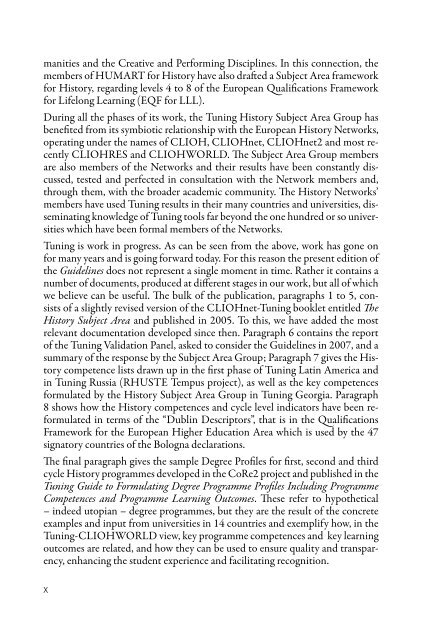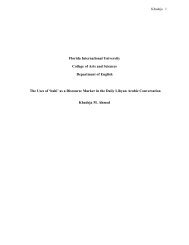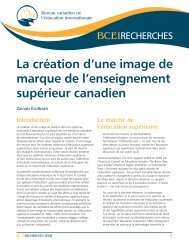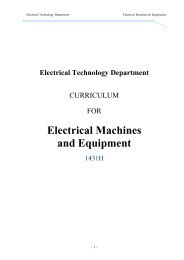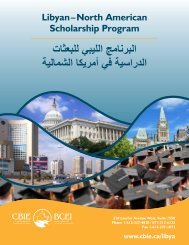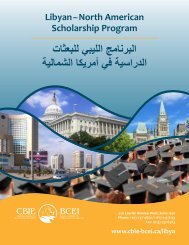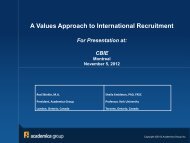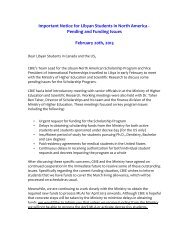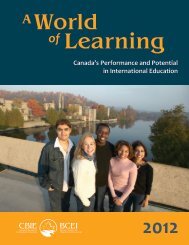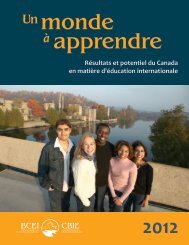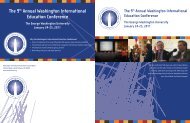Creating a New Historical Perspective: EU and the Wider World ...
Creating a New Historical Perspective: EU and the Wider World ...
Creating a New Historical Perspective: EU and the Wider World ...
Create successful ePaper yourself
Turn your PDF publications into a flip-book with our unique Google optimized e-Paper software.
manities <strong>and</strong> <strong>the</strong> Creative <strong>and</strong> Performing Disciplines. In this connection, <strong>the</strong><br />
members of HUMART for History have also drafted a Subject Area framework<br />
for History, regarding levels 4 to 8 of <strong>the</strong> European Qualifications Framework<br />
for Lifelong Learning (EQF for LLL).<br />
During all <strong>the</strong> phases of its work, <strong>the</strong> Tuning History Subject Area Group has<br />
benefited from its symbiotic relationship with <strong>the</strong> European History Networks,<br />
operating under <strong>the</strong> names of CLIOH, CLIOHnet, CLIOHnet2 <strong>and</strong> most recently<br />
CLIOHRES <strong>and</strong> CLIOHWORLD. The Subject Area Group members<br />
are also members of <strong>the</strong> Networks <strong>and</strong> <strong>the</strong>ir results have been constantly discussed,<br />
tested <strong>and</strong> perfected in consultation with <strong>the</strong> Network members <strong>and</strong>,<br />
through <strong>the</strong>m, with <strong>the</strong> broader academic community. The History Networks’<br />
members have used Tuning results in <strong>the</strong>ir many countries <strong>and</strong> universities, disseminating<br />
knowledge of Tuning tools far beyond <strong>the</strong> one hundred or so universities<br />
which have been formal members of <strong>the</strong> Networks.<br />
Tuning is work in progress. As can be seen from <strong>the</strong> above, work has gone on<br />
for many years <strong>and</strong> is going forward today. For this reason <strong>the</strong> present edition of<br />
<strong>the</strong> Guidelines does not represent a single moment in time. Ra<strong>the</strong>r it contains a<br />
number of documents, produced at different stages in our work, but all of which<br />
we believe can be useful. The bulk of <strong>the</strong> publication, paragraphs 1 to 5, consists<br />
of a slightly revised version of <strong>the</strong> CLIOHnet-Tuning booklet entitled The<br />
History Subject Area <strong>and</strong> published in 2005. To this, we have added <strong>the</strong> most<br />
relevant documentation developed since <strong>the</strong>n. Paragraph 6 contains <strong>the</strong> report<br />
of <strong>the</strong> Tuning Validation Panel, asked to consider <strong>the</strong> Guidelines in 2007, <strong>and</strong> a<br />
summary of <strong>the</strong> response by <strong>the</strong> Subject Area Group; Paragraph 7 gives <strong>the</strong> History<br />
competence lists drawn up in <strong>the</strong> first phase of Tuning Latin America <strong>and</strong><br />
in Tuning Russia (RHUSTE Tempus project), as well as <strong>the</strong> key competences<br />
formulated by <strong>the</strong> History Subject Area Group in Tuning Georgia. Paragraph<br />
8 shows how <strong>the</strong> History competences <strong>and</strong> cycle level indicators have been reformulated<br />
in terms of <strong>the</strong> “Dublin Descriptors”, that is in <strong>the</strong> Qualifications<br />
Framework for <strong>the</strong> European Higher Education Area which is used by <strong>the</strong> 47<br />
signatory countries of <strong>the</strong> Bologna declarations.<br />
The final paragraph gives <strong>the</strong> sample Degree Profiles for first, second <strong>and</strong> third<br />
cycle History programmes developed in <strong>the</strong> CoRe2 project <strong>and</strong> published in <strong>the</strong><br />
Tuning Guide to Formulating Degree Programme Profiles Including Programme<br />
Competences <strong>and</strong> Programme Learning Outcomes. These refer to hypo<strong>the</strong>tical<br />
– indeed utopian – degree programmes, but <strong>the</strong>y are <strong>the</strong> result of <strong>the</strong> concrete<br />
examples <strong>and</strong> input from universities in 14 countries <strong>and</strong> exemplify how, in <strong>the</strong><br />
Tuning-CLIOHWORLD view, key programme competences <strong>and</strong> key learning<br />
outcomes are related, <strong>and</strong> how <strong>the</strong>y can be used to ensure quality <strong>and</strong> transparency,<br />
enhancing <strong>the</strong> student experience <strong>and</strong> facilitating recognition.


